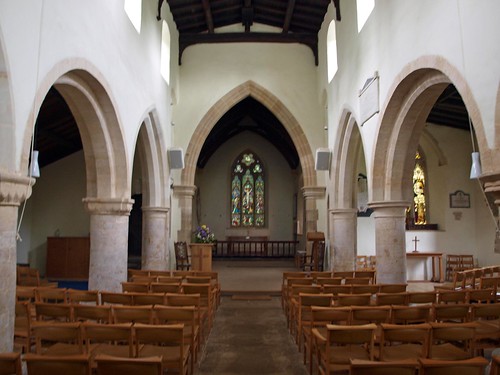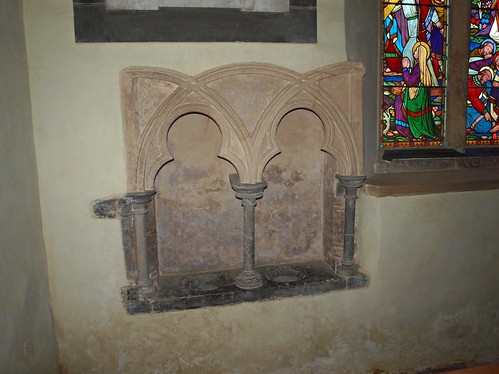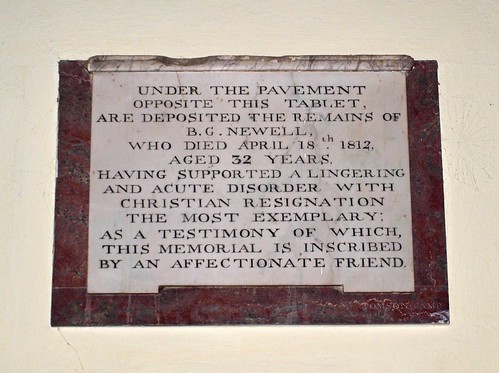ST JAMES. The W tower faces the Ouse. It is a pretty position. The history of the building begins with the N arcade. The middle arch is round with one step and one slight chamfer. The piers are round and sturdy, the abaci square and nicked at the corners. The capitals have small decorated scallops. That makes it c.1180. E bay and W bay are later, late C13 and late C14 respectively. The meeting of two responds W of the E bay deserves a good look. The S arcade has one arch almost identical with the earliest on the N side, but probably some twenty years later. The piers now have round abaci. The E and W bays are as above. The S doorway is over-restored but matches the S aisle. The chancel is mid C13 - see the two N lancets and the lovely DOUBLE PISCINA with its intersecting not only arches but mouldings). The arches stand on Purbeck shafts. Opposite a plain DOUBLE AUMBRY. Finally the details of the Perp W tower. Clasping buttresses, turning diagonal higher up. Ball finials of the C18 on the buttresses, and a truncated recessed spire also crowned by ball finials. The rest of the spire was blown down in the hurricane of 1741. - STAINED GLASS. One window of the S aisle by Kempe, 1906 (still without his future partner Tower). - PLATE. Cup and Paten on foot, 1684-5. - MONUMENTS. Enjoyable cartouches, one inside d 1682, one outside d 1715.
HEMINGFORD GREY. ‘The delicate loveliness of this part of England is here at its best, with fine timbered cottages older than the Armada, and an enchanting peep of the church along the river. One of Nature’s beautiful places, it was the home of two sisters famous for their beauty, and the chosen place of an artist whose pictures will keep his name alive. He gave us a new Thursday and Friday. .
He was Dendy Sadler, who chose to live in this lovely country where the Ouse flows gently by green meadows. He must have loved the old watermill, believed to stand on the foundations of a mill which was here in the days of the Crusades. It was here that he painted his famous pictures called Thursday and Friday, one showing a company of jovial monks fishing in the Ouse, the other showing them enjoying the dinner they had caught the day before. The artist chose most of his models from the village, and truly an artist might choose here scenes for a lifetime of painting. Still the spirit of Dendy Sadler was living in his house when we called, for here we found a lover of Art and Nature getting up at five in the morning to paint his flowers superbly, Mr A. F. Hayward.
The two beautiful sisters lived in the manor house, which has shared the centuries with the church and is still here for us to see; it is the oldest inhabited house in the county, much of it built by the Normans. Some of its walls are three or four feet thick, and one of its gabled fronts, with a Norman mullioned window under a zigzag arch, is a gem.
Here Elizabeth and Mary Gunning grew in beauty side by side, and it was here that the poet Cowper saw them as he was walking by the Ouse one day with his little dog:
Two nymphs adorned with every grace
That spaniel found for me.
A gravestone in the chancel of the church has the names of two younger sisters of the beautiful ones, and most of the church is as it was when the eyes of the congregation would turn aside to see the beautiful sisters step into their pew. The north arcade is Norman, the south is 13th century, and the clerestory belongs to the 15th century, when our English way of building was at its best. The roof timbers are 400 years old and there is a 17th century chest with three locks. The 500-year-old tower has lost its spire, which was blown down about 200 years ago and is said to be lying at the bottom of the river.
The village has a beautiful thatched and timbered cottage which has been inhabited since Queen Elizabeth’s day, and it is interesting for having on its roll of honour of vicars a Charles Dickens who was preaching here long before another man made the name immortal, and a Joseph Banks who was rector here for 54 years while his famous namesake was president of the Royal Society.
The Talk of Half Europe
IN a way it may be said that John Gunning made history when, quitting Ireland for England with his wife, a daughter of Lord Bourke of Mayo, he settled down here. Four little Gunning girls were born here, and of these Mary and Elizabeth became the talk of half Europe, so perfect were they in figure and features. They live in literature as The Beautiful Miss Gunnings.
They were brought to London in 1751 when Elizabeth was 17 and Mary a little older. Society became crazed over their charms. Crowds followed them in their daily walks; no scene in Congreve’s comedies matches the reality of the furore they caused. Soon hearts and coronets were at their feet. The sixth Earl of Coventry laid siege to Mary; the sixth Duke of Hamilton desperately wooed Elizabeth.
Horace Walpole tells us how Hamilton sat at cards one night, neglecting the game and losing hundreds of pounds by making love to Elizabeth, who. was at the other end of the room. In 1752, when she was 18, Elizabeth promised to marry him in the following spring. But he would not wait. He sent late at night for a clergyman and bade him marry them. The minister protested against such haste and irregularity, but at last he was prevailed upon, and half an hour after midnight, with a curtain ring for a wedding ring, the marriage took place at Mayfair Chapel. Three children were born, of whom the daughter became Countess of Derby and two boys became in turn Duke of Hamilton.
Widowed at 24, Elizabeth married a year later the Duke of Argyll and became a mother of two other dukes. Four dukes this mother had for her sons. She was much at Court, she showed great bravery during the Wilkes riots, was made Baroness Hamilton of Hambledon in her own right, and died in 1790. Mary, who is said to have been even lovelier than Elizabeth, married Lord Coventry and lived happily with him for 18 years, dying of consumption in 1760.
He was Dendy Sadler, who chose to live in this lovely country where the Ouse flows gently by green meadows. He must have loved the old watermill, believed to stand on the foundations of a mill which was here in the days of the Crusades. It was here that he painted his famous pictures called Thursday and Friday, one showing a company of jovial monks fishing in the Ouse, the other showing them enjoying the dinner they had caught the day before. The artist chose most of his models from the village, and truly an artist might choose here scenes for a lifetime of painting. Still the spirit of Dendy Sadler was living in his house when we called, for here we found a lover of Art and Nature getting up at five in the morning to paint his flowers superbly, Mr A. F. Hayward.
The two beautiful sisters lived in the manor house, which has shared the centuries with the church and is still here for us to see; it is the oldest inhabited house in the county, much of it built by the Normans. Some of its walls are three or four feet thick, and one of its gabled fronts, with a Norman mullioned window under a zigzag arch, is a gem.
Here Elizabeth and Mary Gunning grew in beauty side by side, and it was here that the poet Cowper saw them as he was walking by the Ouse one day with his little dog:
Two nymphs adorned with every grace
That spaniel found for me.
A gravestone in the chancel of the church has the names of two younger sisters of the beautiful ones, and most of the church is as it was when the eyes of the congregation would turn aside to see the beautiful sisters step into their pew. The north arcade is Norman, the south is 13th century, and the clerestory belongs to the 15th century, when our English way of building was at its best. The roof timbers are 400 years old and there is a 17th century chest with three locks. The 500-year-old tower has lost its spire, which was blown down about 200 years ago and is said to be lying at the bottom of the river.
The village has a beautiful thatched and timbered cottage which has been inhabited since Queen Elizabeth’s day, and it is interesting for having on its roll of honour of vicars a Charles Dickens who was preaching here long before another man made the name immortal, and a Joseph Banks who was rector here for 54 years while his famous namesake was president of the Royal Society.
The Talk of Half Europe
IN a way it may be said that John Gunning made history when, quitting Ireland for England with his wife, a daughter of Lord Bourke of Mayo, he settled down here. Four little Gunning girls were born here, and of these Mary and Elizabeth became the talk of half Europe, so perfect were they in figure and features. They live in literature as The Beautiful Miss Gunnings.
They were brought to London in 1751 when Elizabeth was 17 and Mary a little older. Society became crazed over their charms. Crowds followed them in their daily walks; no scene in Congreve’s comedies matches the reality of the furore they caused. Soon hearts and coronets were at their feet. The sixth Earl of Coventry laid siege to Mary; the sixth Duke of Hamilton desperately wooed Elizabeth.
Horace Walpole tells us how Hamilton sat at cards one night, neglecting the game and losing hundreds of pounds by making love to Elizabeth, who. was at the other end of the room. In 1752, when she was 18, Elizabeth promised to marry him in the following spring. But he would not wait. He sent late at night for a clergyman and bade him marry them. The minister protested against such haste and irregularity, but at last he was prevailed upon, and half an hour after midnight, with a curtain ring for a wedding ring, the marriage took place at Mayfair Chapel. Three children were born, of whom the daughter became Countess of Derby and two boys became in turn Duke of Hamilton.
Widowed at 24, Elizabeth married a year later the Duke of Argyll and became a mother of two other dukes. Four dukes this mother had for her sons. She was much at Court, she showed great bravery during the Wilkes riots, was made Baroness Hamilton of Hambledon in her own right, and died in 1790. Mary, who is said to have been even lovelier than Elizabeth, married Lord Coventry and lived happily with him for 18 years, dying of consumption in 1760.



No comments:
Post a Comment